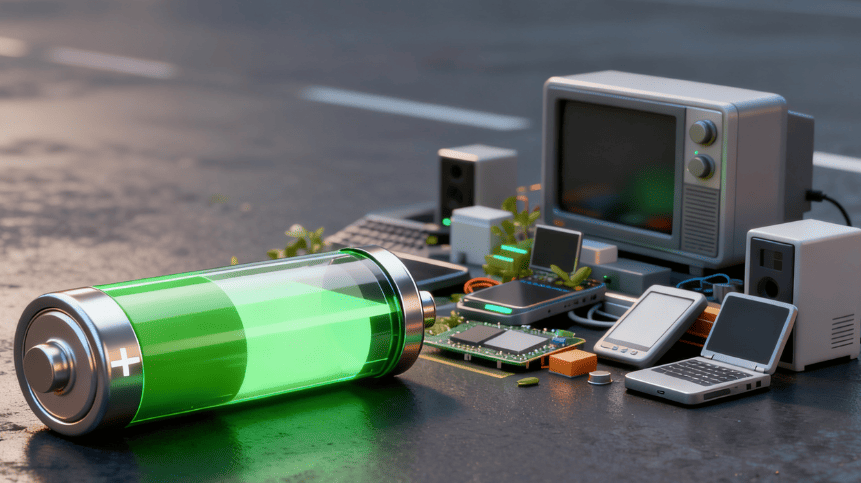Do Batteries Expire? Understanding the Shelf Life of Alkaline, Lithium, and Rechargeable Batteries

Do Batteries Really Expire?
At first, it might sound like a simple question — like asking whether milk or sour cream goes bad after its expiration date. But batteries are different. While some can still function after their labeled “expiry,” others may degrade or become unusable.
Let’s break down why batteries expire, how long they last, and what happens as they age.
1. Alkaline Batteries: Long Shelf Life but Gradual Decline
Standard alkaline batteries (AA, AAA, etc.) have a relatively long shelf life of 5 to 10 years. They self-discharge slowly, losing about 2–3% of their energy per year.
While they never truly reach “zero,” their voltage eventually drops below what most devices require. However, even a “dead” alkaline battery can still power low-drain devices such as remote controls or wall clocks for a short time.
Key takeaway: Alkaline batteries are reliable for long-term storage and low-power applications, but they gradually lose effectiveness over time.
2. Lithium Primary Batteries: Extremely Stable and Long-Lasting
Lithium primary batteries (non-rechargeable) provide higher voltage and exceptionally low self-discharge — around 1% per year.
Because of their chemical stability, these batteries can hold a charge for many years, making them ideal for long-term storage and devices that require reliable, instant power (like cameras or medical sensors).
Still, they do eventually expire once their voltage drops below the usable threshold.
Best use: Long-term storage, critical backup systems, and emergency kits.
3. Rechargeable Lithium-Ion Batteries: High Performance but Shorter Shelf Life
Lithium-ion (Li-ion) batteries are the most common rechargeable type — used in phones, laptops, and power tools — but they have a shorter shelf life of 2 to 3 years.
Their relatively high self-discharge rate (2–5% per month) and built-in Battery Management System (BMS) cause a constant, small drain. Over time, the battery’s internal chemistry degrades, reducing capacity even when unused.
However, Li-ion batteries can be recharged hundreds of times, making them cost-effective and environmentally friendly. Even as they age, they usually remain functional — just with shorter run time.
Note: Proper storage (at 40–60% charge, in a cool, dry place) can help extend Li-ion battery lifespan.
4. Best Batteries for Emergency Power Preparedness
For emergency or off-grid power, it’s best to keep both alkaline and Li-ion batteries on hand:
-
Li-ion batteries are rechargeable via solar panels, power banks, or generators — ideal for sustainable, reusable power.
-
Alkaline batteries provide instant energy and retain most of their charge even after years in storage.
Drawback:
-
Stored Li-ion batteries may discharge and need recharging before use.
-
Alkaline batteries, while ready to use anytime, cannot be recharged.
Combining both types ensures reliability — immediate power plus long-term sustainability.
5. Can You Use 10-Year-Old Batteries?
That depends on the type:
-
Alkaline: After a decade, they’ll have lost about 50% capacity, but may still work in low-drain devices.
-
Primary Lithium: Retain most of their charge and are often still usable in small electronics like calculators or key fobs.
-
Rechargeable Li-ion: After 10 years, they’re usually heavily degraded, with most capacity lost and poor current delivery.
Tip: Always inspect older batteries for leakage, swelling, or corrosion before use.
6. When Is a Battery at “End of Life”?
For rechargeable batteries like Li-ion, “end of life” usually means it can only hold 80% of its original capacity.
Even then, it’s often still functional — many devices can operate with slightly reduced voltage or capacity. In other words, while a battery may “expire” in terms of performance, it doesn’t become completely useless.
Proper battery recycling or repurposing (for low-drain applications) is the best next step once capacity noticeably declines.
Conclusion: Batteries Don’t “Expire” — They Gradually Fade
Batteries don’t have a hard expiration date like perishable food. Instead, their chemistry changes over time, leading to reduced voltage and capacity.
-
Alkaline batteries are great for long-term storage.
-
Primary lithium batteries excel in durability.
-
Rechargeable Li-ion batteries offer flexibility and sustainability but require proper care.
Understanding how each type ages helps you choose the right one — whether you’re powering emergency gear, industrial devices, or everyday electronics.
-

 May.2025.11.24Ternary Lithium Battery vs Lithium-ion: Complete Comparison Guide (2025 Edition)Learn More
May.2025.11.24Ternary Lithium Battery vs Lithium-ion: Complete Comparison Guide (2025 Edition)Learn More -

 May.2025.11.214S2P 18650 14.8V Battery: Complete Technical Guide, Specs, Applications & SafetyLearn More
May.2025.11.214S2P 18650 14.8V Battery: Complete Technical Guide, Specs, Applications & SafetyLearn More -

 May.2025.11.18PCM vs BMS in Lithium Batteries: What’s the Difference and Which One Do You Need?Learn More
May.2025.11.18PCM vs BMS in Lithium Batteries: What’s the Difference and Which One Do You Need?Learn More -

 May.2025.11.17Custom Li-ion Battery Design for Medical Devices (2025 Comprehensive Guide)Learn More
May.2025.11.17Custom Li-ion Battery Design for Medical Devices (2025 Comprehensive Guide)Learn More -

 May.2025.11.17The Future of Lithium-Ion Batteries: Innovation, Sustainability, and Global Market TrendsLearn More
May.2025.11.17The Future of Lithium-Ion Batteries: Innovation, Sustainability, and Global Market TrendsLearn More















